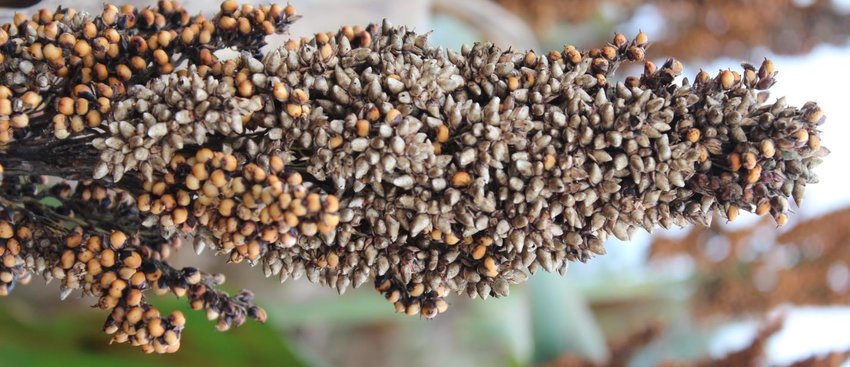Covered Kernel Smut is a common disease in sorghum, including johnsongrass. It’s caused by the fungus Sporisorium sorghi and is most prevalent when farmers use untreated seeds.
Infected sorghum heads show powdery masses of dark brown spores covered by a tough membrane. These spores spread to healthy seeds, causing new infections.
Infected seeds sprout with the spores, which then infect the young sorghum plant. The fungus grows inside without harm until the plant matures. At that point, the spores take the place of kernels and are surrounded by a covering. This covering breaks, releasing spores that can contaminate seeds and soil.
Planting seeds in warmer, moist soil reduces the disease. Different types of the fungus exist with distinct characteristics.
For Quick Guide of Covered Kernel Smut Sorghum , Download this PDF:
Characteristics of Smut Sori:
- Sorghum grains are replaced by spore-producing structures called smut sori.
- These structures have a persistent membrane (peridium) and come in various sizes, from those hidden by glumes to over 1 cm long.
- Most sori are conical or oval and resemble elongated sorghum seeds.
- They can be whitish, gray, or brown, sometimes with stripes.
- Sori typically measure 0.4-1.3 cm in length and 0.2-0.4 cm in width.
- Infected heads may have localized sori at the top, bottom, or side.
Distinctive Features:
- The spore-producing structures (smut sori) can be conical or oval-shaped.
- They have a persistent coat and can be covered by glumes, extending to over 1 cm in length.
- The glumes maintain their normal color.
- Most sori have a conical or oval shape, resembling elongated sorghum seeds.
- Colors vary from whitish to gray or brown, sometimes with stripes.
- Often, only parts of the head are affected by smut.
- In severe cases, the panicle branches may be entirely destroyed, leaving behind a distorted central stem structure covered in sori.
Symptoms of Covered Kernel Smut Sorghum:

Covered Kernel Smut Symptoms:
- The disease replaces individual grains with smut sori.
- Sori are covered by a creamy skin and can appear in specific parts of the head or all over it.
- Ratoon crops tend to have a higher incidence of the disease.
Unusual Symptoms:
- Occasionally, individual spikelets or inflorescences may be missing in smutted panicles.
- This can result in panicles with twisted, distorted branches covered in large, superficial smut sori.
Also Read: Head Smut of Sorghum: What Is It, Symptoms, Management
Management of Covered Kernel Smut Sorghum:
Preventing Method:
Izumonas-Best Fungicide
Contents: Pseudomonas Fluorescens
IZUMONAS is a biological product consisting of plant growth-promoting rhizobacteria (PGPR), which are naturally occurring bacteria found widely in nature. This unique product is designed to enhance plant defence mechanisms and promote healthy growth. IZUMONAS can be used on all types of crops without leaving any residue on the plants.
Izumil-Best Fungicide
Contents:
- Extract of Streptomyces griseus: 30%
- Extract of Streptomyces violaceus: 40%
- Dissolving agents: 30%
IZUMIL is a remarkable biotech research product that has been developed to activate the natural defence mechanism of plants. By using IZUMIL, plants can better protect themselves against fungal pathogens, improve their physiological functions, and develop resistance against various harmful microorganisms. Similar to IZUMONAS, IZUMIL can be safely used on all crops without leaving any residue.
Modes of Use:
- Seed Treatment: Mix 5-10 ml of IZUMONAS and IZUMIL per kilogram of seeds in an adequate amount of water. Submerge the seeds in this solution and allow them to dry in a shaded area before sowing.
- Seedling Treatment: Combine 100 ml of IZUMONAS and IZUMIL per 20 litres of water. Dip the roots of the seedlings in this solution for approximately 30 minutes prior to transplanting.
- Soil Application: Mix 500 ml of IZUMONAS and IZUMIL with 30 kilograms of farmyard manure (FYM) or soil. Apply this mixture to one acre of land before ploughing or irrigation.
- Foliar Application: Dilute 2-3 ml of IZUMONAS and IZUMIL each in 1 litre of water. Use this solution to spray the entire foliage of the plants, ensuring complete coverage on both sides of the leaves. It is advisable to shake the bottle before use. For best results, spray early in the morning or evening. If a power sprayer is used, double the recommended dosage.
Cultural Method:
- Crop rotation:
- Avoid consecutive sorghum or related grass crop planting in the same field.
- Prevents buildup of loose smut pathogen in soil.
- Treating seeds:
- Treat sorghum seeds with fungicides before planting.
- Reduces or eliminates loose smut pathogen in seeds.
- Using healthy seeds:
- Source seeds from trusted suppliers.
- Ensure seeds are certified disease-free.
- Keeping things clean:
- Remove and destroy infected plant debris.
- Prevents disease spread.
- Planting strong kinds:
- Choose sorghum varieties resistant to loose smut.
- Decreases disease impact.
- Picking the right planting time:
- Opt for periods with less favorable conditions for disease development.
- Controls disease growth.

